13 Oct
Transmissible venereal tumour

In spring 2021, Vet Times carried news1 of an increase in the diagnosis of transmissible venereal tumour (TVT) in dogs in this country, mainly in animals imported unwisely from overseas – in particular, Romania.
TVTs are unusual cancers that occur only very rarely in nature. They are malignant somatic cells that spread by direct transfer between individuals. Many “normal” cancers metastasise to distant and different tissues within one organism; TVTs spread in a similar way as allogeneic cloned cells between individuals of the same species.
Only two natural TVTs are known in mammals – that in dogs of which an increase in UK case numbers has been reported, and the two facial tumours found in Tasmanian devils (Sarcophilus harrisii) in the 1990s and 2014, which have decimated that island marsupial’s population so severely it is now considered endangered.
In dogs the parasitic cell clone spreads through coitus and, therefore, most commonly occurs around the genitalia of dogs, although non-genital cases spread by licking, sniffing and at parturition are reported. Facial tumours in Tasmanian devils are spread by biting, which is common in this species2. Conventional neoplastic metastases occur only rarely.
In dogs, the extended time taken for mating when dogs “tie” is thought to enable damage to the genital mucosa to occur, and therefore enable the implantation of TVT cells by infected individuals.
Oestrogen receptor expression has been found to be different between the genitalia of bitches with TVTs and those without, and it is suggested that this is a mechanism of the TVT to change the local tissue environment to its advantage. Tumour growth is reportedly rapid, although, because the disease is primarily found in free-roaming dogs of unregulated behaviour, it is hard to know exactly. The author has seen cases in young free-roaming bitches soon after their first oestrus.
Establishment
Initially, tumours occur in the mucosa in the vagina or on the penis/prepuce and will not be readily detected without close examination. In bitches, digital vaginal exploration will reveal roughened nodular areas in the vaginal mucosa (Figures 1 and 2).
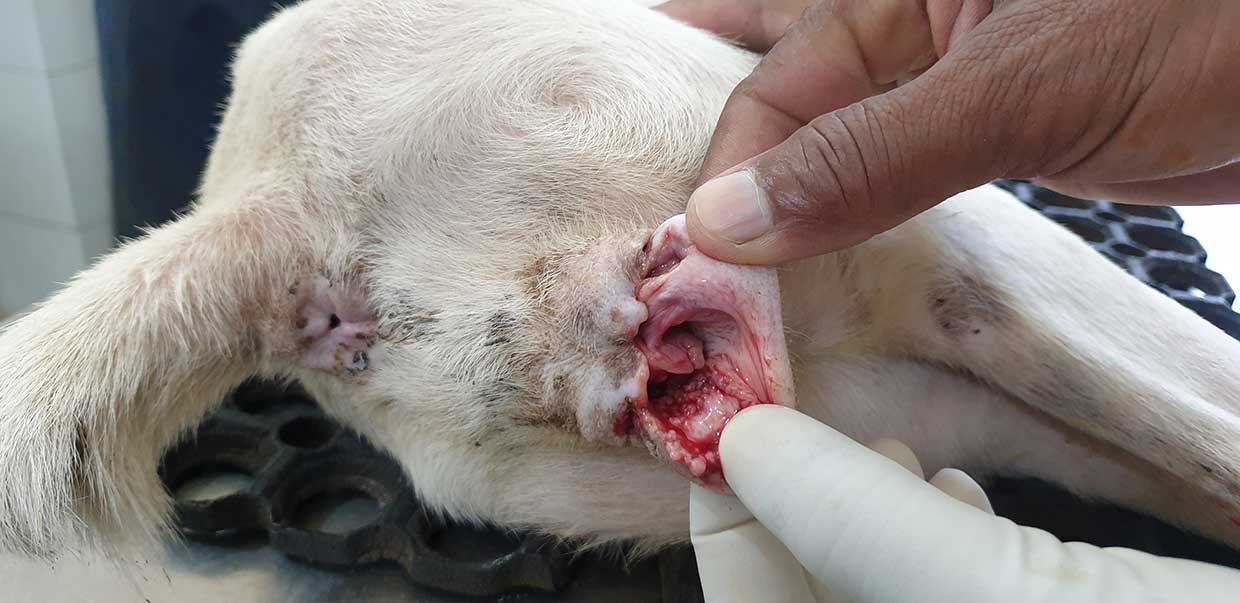
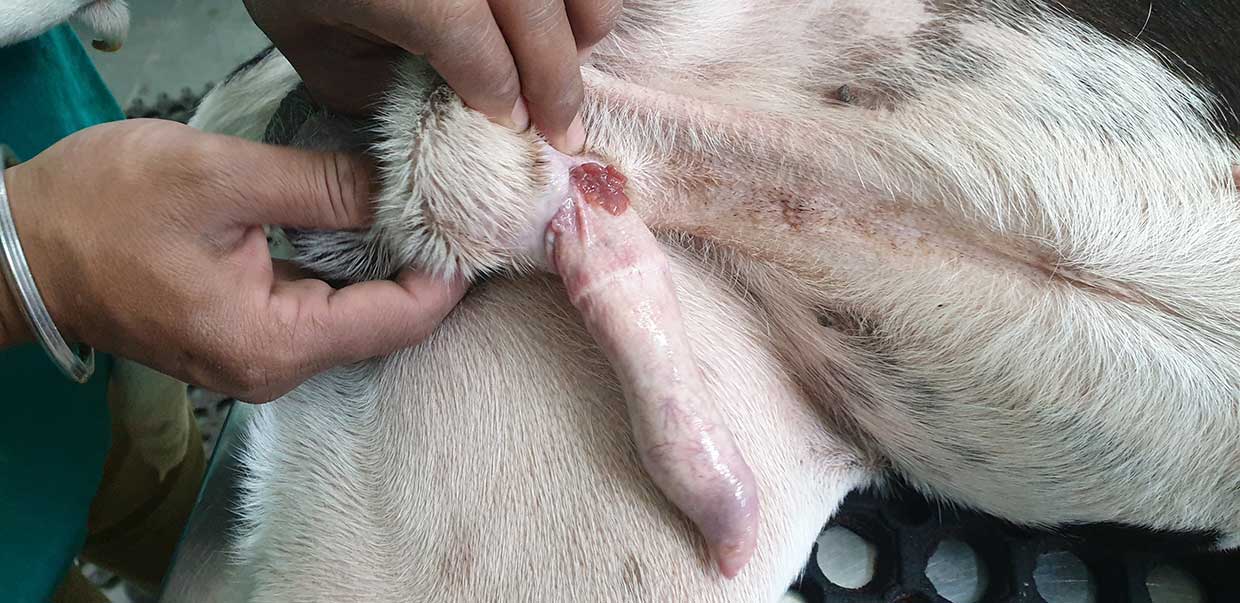
In male dogs similar roughened nodular areas may be seen – especially deep in the preputial sulcus, which is an area that is difficult to visualise, certainly in the conscious male. As the tumour grows it becomes a friable, lobulated cauliflower-like, erythematous mass.
Tumours bleed readily and are only delicately encapsulated. This is believed to be an evolutionary adaptation to optimise the release of TVT cells during coitus. As the tumours grow they begin to distort the normal anatomy of the pudenda in both sexes. In bitches this often presents as a midline perineal swelling. In males the prepuce can appear large and swollen, particularly caudally (Figure 3).
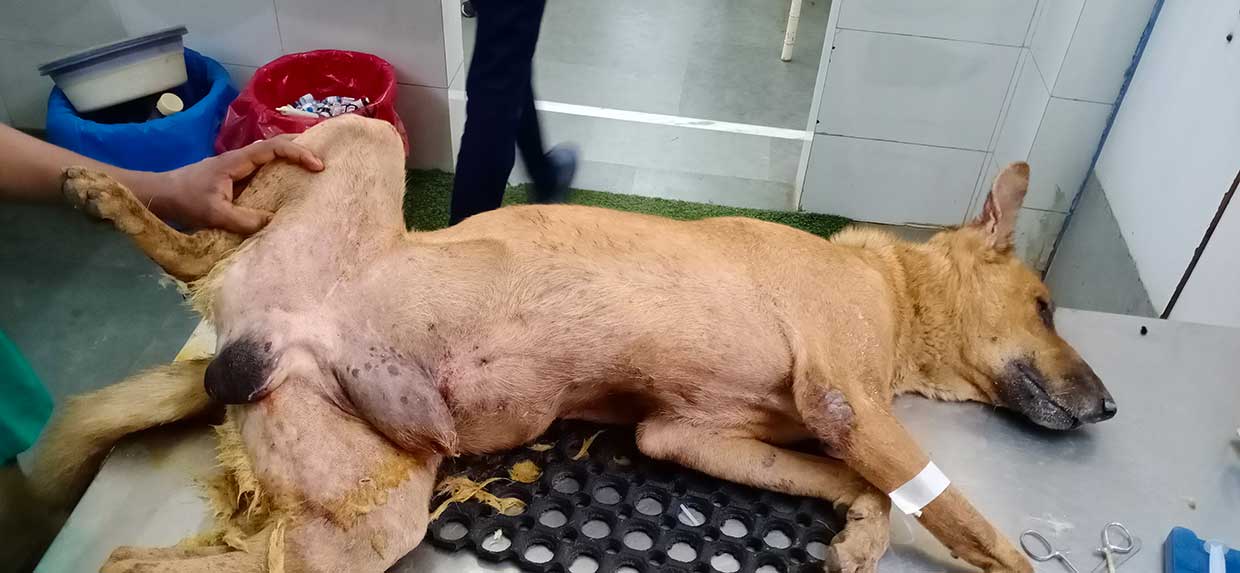
In both sexes a bloody discharge may be noted from the vulva or preputial orifice. This may occasionally be frank blood; only rarely is there pus. In bitches the bloody discharge could easily be mistaken for signs of oestrus. If left untreated, as would often be the case in free-roaming dogs, the tumour in bitches will cause gross distortion and erosion of the vulva and perineum erupting out all around the vulva (Figure 4).
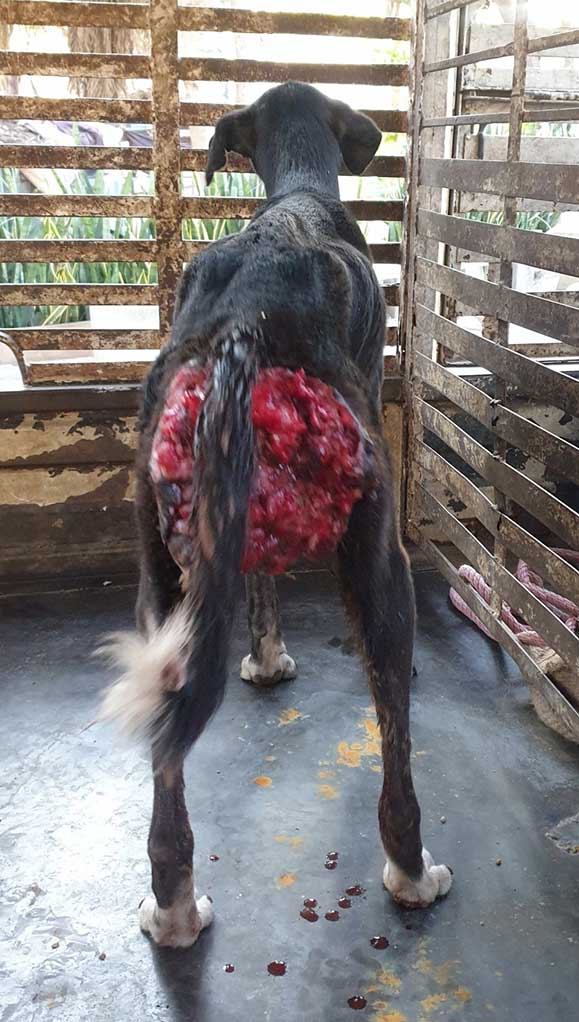
Even in very large tumours interference with urination through occlusion of the urethral orifice does not seem to occur. Similarly, affected pregnant bitches seem able to whelp despite the presence of large TVT tumours, possibly because of the friable nature of the tumours. Differential diagnoses would include other vaginal tumours, vaginal prolapse and vaginal oedema3.
Other vaginal tumours are commonly leiomyoma and these are usually well encapsulated. They may be distinguished from TVT by the roughened, multi-lobulated, friable nature of TVTs. Vaginal oedema is oestrogen dependent in the bitch and should resolve outside of oestrus. The protruding tissue will appear to be like normal healthy vaginal epithelium and in most cases should be easy to differentiate from TVT by digital vaginal examination.
In male dogs the tumour appears similar to the lobulated fragile haemorrhagic tumour seen in bitches. In the author’s experience, TVT tumours are often located in the deepest recesses of the prepuce. To visualise this area, sedation is usually required as the prepuce must be fully retracted and the penis fully advanced to allow examination of the bulbus glandis and caudal penile shaft.
As the tumour grows it may cause gross swelling of the prepuce. The tumour may also mean it is impossible to extrude the penis and tumour from the preputial opening. TVTs of medium or large size that prevent extrusion will usually bleed freely during the effort to visualise the penis.
Myiasis
In both sexes a common sequel in dogs with large TVTs is myiasis (Figure 5). In India, this would almost certainly be by the maggots of the Old World screwworm fly (Chrysomya bezziana). Thankfully, the climate of the UK should mean this frightful primary myiasis fly cannot become established here as it requires a minimum temperature above 10˚C, but it seems highly likely that the fly species associated in the UK with strike in other species would take advantage of advanced canine TVTs.
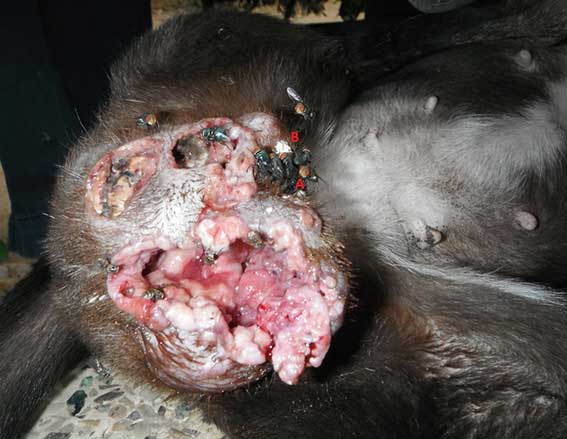
In India, TVT cases under treatment are routinely given ivermectin to reduce or halt the possibilities of further myiasis occurring. Dogs with very advanced, large TVTs become emaciated and anaemic due to the blood losses from the friable tumour, although evidence suggests TVTs may stimulate erythropoietin production to stimulate erythrocyte production to compensate for the haemorrhage from the friable tumour4. This adaptation has been suggested to be an evolutionary survival mechanism by the malignant cell clone that is TVT.
Should histopathological confirmation of the diagnosis be required, obtaining samples of TVT tissue should present no difficulties due to their friable nature. Histologically, the tumours are composed of homogenous large round cells with centrally located nuclei.
Treatment
The treatment of choice in the author’s opinion is IV injection of the chemotherapeutic agent vincristine sulphate at a dose of 0.025mg/kg once a week for between three and six weeks. Care must be taken to ensure that no vincristine is allowed to enter the perivascular tissues as severe necrosis can occur, leading to sloughing wounds around the injection site.
Vincristine is a plant alkaloid that inhibits microtubule formation during cell division. It upsets cell division in all rapidly dividing cells, not only cancerous ones.
Certainly, the most common side effects seen in treating TVT with vincristine affect the gastrointestinal (GI) tract with inappetence, vomiting and diarrhoea. The author’s experience of treating TVTs with vincristine has been entirely in India. In the UK far greater regulatory controls will exist on the use of such chemotherapeutic agents, which should be adhered to.
The common GI tract side effects of vincristine are treated with appetite stimulants. The prognosis for complete resolution of TVT under vincristine therapy is good; most cases respond quickly and dramatically (Figure 6). Even large tumours regress very quickly and the anatomical disruption caused by the tumour repairs without further intervention. In TVT unresponsive to vincristine, texts recommend the use of doxorubicin (used under the cascade) at 1mg/kg for dogs more than 10kg bodyweight, given every three weeks5.
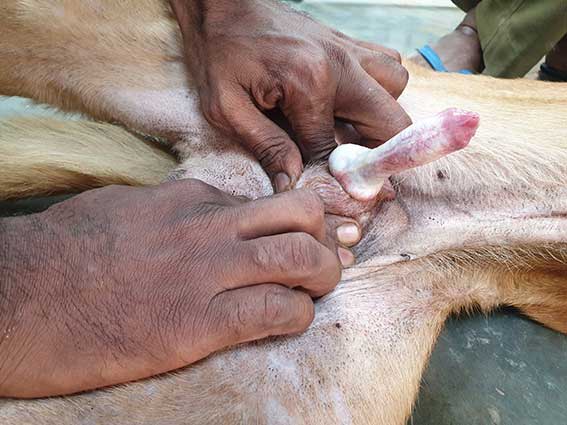
Some sources suggest surgical excision as a satisfactory and successful treatment. Given the very friable nature of TVT and what is known about the modes of transmission of the TVT parasitic cell clones, the author considers that surgery may result in large-scale “seeding” of the tumour’s cells to tissues damaged during surgery.
Prevention
Prevention of TVT is by ensuring dog breeding is controlled and using only animals known to be free from the tumour. The decline, indeed disappearance, of TVT from dog populations in the UK and other western countries has been due to the management and elimination of free-roaming dog populations, and the attendant uncontrolled reproduction6.
Research by the University of Cambridge Department of Veterinary Medicine into the molecular genetics of TVT revealed that the condition arose in one dog in central Asia several thousand years ago and, although the original cancerous dog has long since died, the tumour cells have since spread across the world so that it is now the oldest, most prolific cancer lineage known.
The implanted tumour cells may be considered an allogeneic graft and would normally cause, in the host, a potent immune response involving the major histocompatibility complex (MHC) molecules. TVT cells, and those of the Tasmanian devil facial tumours, evade the immune system as they have lost, presumably by immune-selection, the expression of MHC molecules6.
With the increase in numbers of dogs – particularly “stray” dogs – imported into this country from countries where free-roaming dog populations are tolerated, the cases of TVT found here are rising. TVT must now be considered in dogs presenting with haemorrhagic swellings of the pudenda in both sexes.
